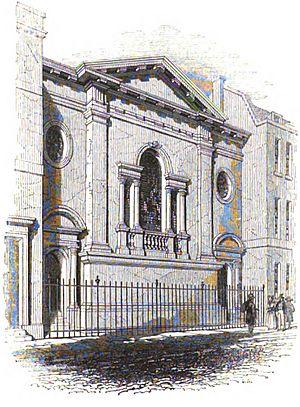St Alphege London Wall facts for kids
Quick facts for kids St Alphege London Wall |
|
|---|---|
 |
|
| Location | London |
| Country | United Kingdom |
| Denomination | Anglican |
| Architecture | |
| Style | Gothic Baroque |
St Alphege London Wall was a historic church in the City of London, England. It was built right next to the ancient London Wall. Because it was so close to Cripplegate, it was also known as St Alphege Cripplegate. Today, the area where the church once stood is a public park called St Alphage Garden.
The Story of St Alphege Church
The church of St Alphege used two different buildings over time. First, there was an original church. Later, the church moved to a former priory building nearby. This happened after King Henry VIII closed down many monasteries and religious houses in England.
The First Church Building
The very first St Alphege church was built right against the London Wall. The wall actually formed the northern side of the church! The churchyard, which is like a graveyard, was just north of the wall.
People first mentioned this church around the years 1108–1125. However, some believe it was built even earlier, before 1068. The church was closed down by a special law at the end of the 1500s. After that, it was taken down, but the London Wall itself was left standing.
The land where the church once stood became a carpenter's yard. Then, in 1837, it was turned into a public garden. This garden is still there today. You can even see a preserved part of the London Wall on its northern edge. A road that used to run past the church site was renamed St Alphege Gardens.
The churchyard north of the London Wall was open until 1677. But later, buildings were put up on that land. The last building there, which used the London Wall as its southern border, was destroyed by bombs in the Second World War. This bombing uncovered the old Roman city wall, which the medieval wall had been built on top of.
When a new building called Salters' Hall was built on the site in 1976, the area north of the London Wall became a garden for the Hall.
The Priory Church
The second church building for St Alphege started as a church for a group of nuns. This was the Priory Church of St Mary-within-Cripplegate. It was probably founded before the year 1000. But by 1329, the nunnery was not doing well.
The land then went to a man named William Elsing. He started a hospital there called Elsing Spital in 1331. At first, it was a regular hospital. But in 1340, it became a place for Augustinian canons, who were a type of religious group. The hospital closed in 1536 when King Henry VIII dissolved the monasteries.
After the first St Alphege church closed, this Priory Church became the new parish church for the area. The rest of the hospital site was sold to Sir John Williams. He built a private house there, but it burned down in 1541. The property was sold again and used to create Sion College in 1630.
The church building was repaired in 1624. The top part of its tall tower, called a steeple, was rebuilt in 1649. The church was damaged but not completely destroyed during the Great Fire of London in 1666.
More repairs were done in 1684 and 1701. In 1711, the church members asked for money to make the building bigger, but they didn't get it. By 1747, the steeple was in such bad shape that the bells couldn't be rung. Four of the six bells had to be sold.
Rebuilding the Church
In 1774, people realized the church was not safe to use. A group was formed to plan its rebuilding. This cost about £1350, and they kept the old tower. The new church opened on July 24, 1777.
The rebuilt church had two main entrances. One faced Aldermanbury to the east, and another faced London Wall to the north. One person described them as not very beautiful. The inside of the church was a simple room with a flat ceiling. The pulpit, where the speaker stands, was unusually placed at the back wall. This meant the people listening faced away from the altar.
By 1900, the tower and entrance area were in poor condition again. The north entrance was rebuilt in 1913 with a new Gothic-style look.
The church was damaged during an air raid in the First World War. In 1917, its parish joined with another church, St Mary Aldermanbury. The church was rebuilt in 1919, but it was planned to be torn down that same year. The bells were moved to St Peter’s Acton. The main part of the church, called the nave, was taken down in 1923. Only the tower and the entrance area were left. Until the Second World War, the tower was kept as a place for prayer.
The tower was badly burned in a fire in 1940. The City of London Corporation started to rebuild the bombed area in 1958. This was part of creating the new Barbican Estate. During this building work, the early 1900s north entrance and the top parts of the tower were removed.
In 2018 and 2019, as part of a project to build a raised walkway, the remaining parts of the church tower and the area around it were updated. They now form a central part of a new public space called London Wall Place & St Alphage Gardens.
The remains of the church were officially recognized as a Grade II listed building on January 4, 1950. What's left today is the ruin of a central tower. It's made of flint and stone, with arches on three sides. The south wall is missing.
In 1954, the combined parish of St Alphege was joined with St Giles-without-Cripplegate.
Images for kids





